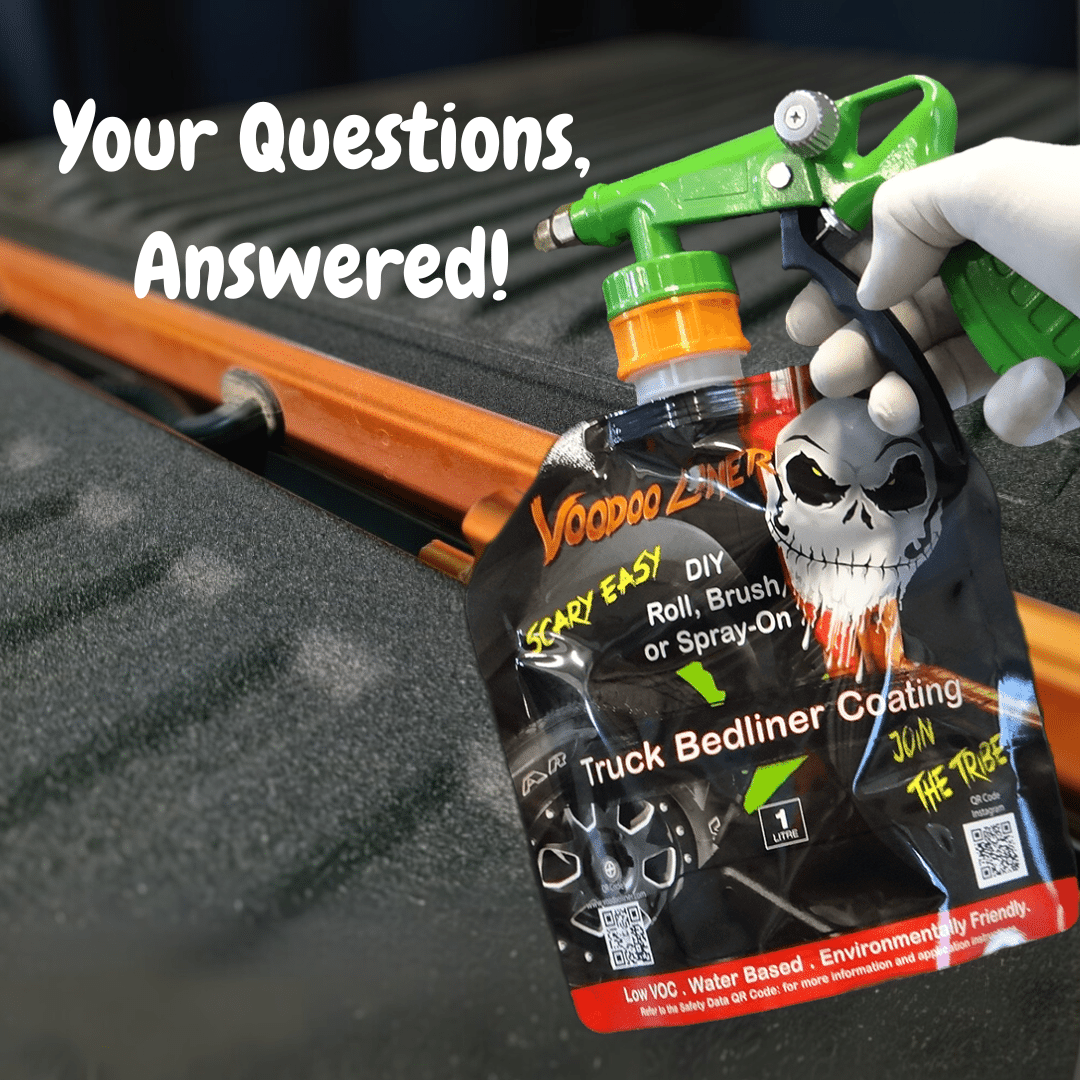We know that choosing the right bed liner or protective coating can be a big decision. Whether you’re a DIY enthusiast or a professional looking for reliable solutions, we’ve got you covered – literally! Here are some of the most common questions we get, along with the answers to help you make the best choice:
- Can Voodoo Liner be applied to any surface?
Voodoo Liner can be applied to almost any surface, making it a versatile choice for protection and durability. It is commonly used on truck beds, bull bars, bonnets, and even entire vehicles.
While Voodoo Liner works on most surfaces, it’s important to note that surfaces prone to movement or flexibility (such as tire flaps and the rubber seals on wheel fender flares) may not be ideal for application, as the coating may not adhere property over time.
For best results, the surface should be sanded to create a roughed surface that allows the Voodoo Liner coating to grip effectively. Additionally, it must be clean, dry, and free of oil, dirt, and any previous coatings to ensure strong adhesion.
- How much do I need for my car?
The amount of Voodoo Liner needed depends on the surface area you’re coating and the level of protection required. For a standard ute tray coating, 4 liters is recommended, providing a durable and reliable coating. If the tray is intended for commercial or tougher use, applying additional layers will enhance durability, so having extra litres available is a good idea.
When coating an entire vehicle, the quantity varies depending on its size. As an example, a Mitsubishi Triton, including inside the canopy, would require approximately 8 litres of Voodoo Liner to achieve full coverage. To ensure optimal results, having enough product on hand to apply multiple coats will help strengthen and prolong the protection.
- How to prep for Voodoo Liner?
Before applying the bed liner coating, proper surface preparation is essential for a strong and lasting bond. Start by thoroughly sanding the surface to create a rough texture, ensuring that rust, old coatings and imperfections are effectively etched away. From this with a deep clean using acetone to remove all dirt, debris, and contaminants, as this step significantly improves adhesion. Throughout the process, wear a respirator mask to protect yourself from harmful dust and chemical particles. Taking the time to prep correctly ensures a durable, professional-quality finish.
- How do I apply Voodoo Liner?
Applying Voodoo Liner is scary easy! Simply open the 1ltre can / bladder pouch, connector it to the Voodoo Liner spray gun (and the gun connector if you’re using a bladder pouch), and start spraying.
For more detailed application instructions, including best practices for surface prep and coat layering, check out this blog: https://voodooliner.com/how-to-apply-voodoo-liners-bed-liner-spray-paint/
- What is the clean up process?
Cleaning up after applying Voodoo Liner is quick and easy. Since it’s water-based, all you need is clean water to flush out the spray gun. After finishing your spraying session, grab a cup of water, place the suction tube inside, and spray until the water runs clear. Repeat this process a couple of times. For thorough cleaning, place your finger over the spray gun’s tip outlet to push water back down the tube into the cup, ensuring the inside of the tube is fully rinsed. This method helps keep the spray gun in great condition, allowing for multiple uses without clogging or buildup.
- What’s the difference between Sinister Sealer and JuJu Sealer?
Sinister Sealer and JuJu Sealer serve different roles in coating finishes. Sinister Sealer sits atop the Voodoo coating, forming a hard shell that repels water, adds sheen, and enhances durability. Best applied with a gravity feed gun for a smooth coat. JuJu Sealer, on the other hand, saturates the surface without altering its look, though it may slightly deepen the color. Once cured, it delivers impressive water beading and sheeting. Essentially, Sinister Sealer focuses on protection and aesthetics, while JuJu Sealer prioritises waterproofing.
- What’s the best way to store unused Voodoo Liner for future applications?
Since Voodoo Liner is water-based, it is recommended to be stored in a cool, dry place, away from direct sunlight and extreme temperatures. Make sure the lid of the pouch / can is sealed tightly to prevent air exposure and avoid premature drying or thickening. If storing for an extended period, it’s recommended to shake the pouch / can periodically. When ready to use again, stir or shake the product well to restore its original texture. Following these steps will help maintain Voodoo Liner’s quality, ensuring it’s ready for a smooth and effective application.
- Is there a recommended maintenance for Voodoo Liner?
Maintaining Voodoo Liner is simple and ensures long-lasting durability. Regular cleaning with mild soap and water helps remove dirt and debris without compromising the coating. For tougher grime, a pressure washer can be used, but keep the nozzle at least 20 inches away to prevent accidental damage. Avoid using harsh chemicals or abrasive cleaners, as they may degrade the protective layer over time. If the surface experiences heavy wear, applying an additional touch-up coat can help restore its strength and appearance. Proper maintenance will keep your Voodoo Liner looking great and performing at its best for years to come!
- Can Voodoo Liner be applied without a spray gun?
While Voodoo Liner is designed for spray application, it can also be applied using a brush or roller for small projects or touch-ups. Using a microfiber roller helps achieve a smooth, even coat, while a brush is great for detailed areas. However, for larger surfaces, a spray gun is recommended to ensure consistent coverage and a professional finish.



